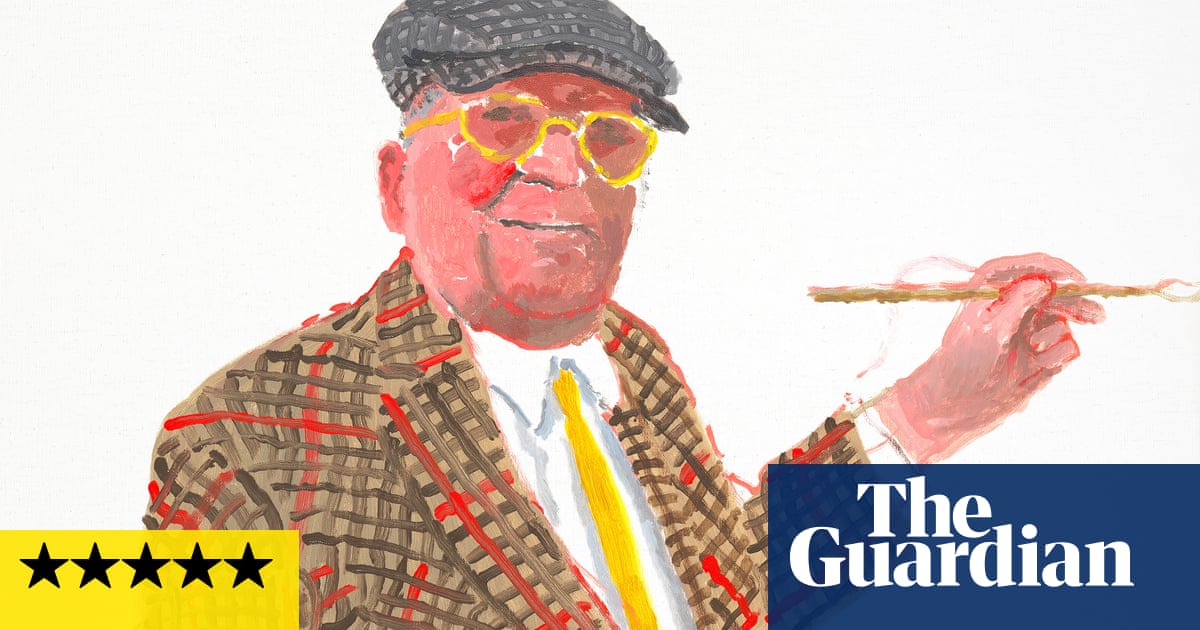
pringtime with Hockney – what a glorious prospect! Just think of all those darling buds and greening hedgerows, dew on fresh grass, cherry blossom bursting into pink and white froth beneath brilliant blue skies: an ideal antidote to the winter’s lockdown. The subject matter of the artist’s new show is as simple as a child’s primer, and ought to spell out unqualified joy. But something stymies the pleasure of these images: namely, the method of their making.
In late 2019, at the age of 82, David Hockney moved to a timbered house in rural Normandy to observe the arrival of spring. He had already depicted the season’s wild beauty in his native Yorkshire with the magnificent charcoal drawings of 2014. Now he uses an iPad and stylus to make daily paintings of his French surroundings. The compositions are basic and stock: central tree, low horizon, distant hill, big bright sky; though the scene is occasionally viewed through an open door.
Two sun-loungers make a brief appearance. Van Gogh’s sharply receding fields are evoked. Monet’s garden at nearby Giverny is acknowledged in a quartet of rain-spattered lily ponds.
But otherwise, the galleries of the Royal Academy are a vision of uniformity: 116 identically sized pictures dominated by Hockney’s hyperbolic palette of neon yellow, shocking pink, felt-pen lime and turquoise. Which throws the emphasis very thoroughly on the small differences between notations, which is to say, on technology.
Hockney uses the free app Brushes, and it shows in every millimetre of these huge enlargements. Forget the virtuoso subtlety of his draughtsmanship in the 60s and 70s, or the originality of his American paintings. What you are looking at here is the expressive limitation of his virtual tool box.
A graze of parallel lines stands for a leaf or cloud; dots of different density are used for seeds, flowers or rising suns; grass comes ribbed, knitted or in sharp little toothpicks. Ready-made motifs proliferate. Blossoms are arrays of danish pastry whorls, both ugly and unpersuasive. Even the innately beautiful structure of a tree is undermined by the stick-figure lines, which lack all eloquence or fluidity. The register is as false and fudged as an electronic signature.
The status of these works is a puzzle. Hockney calls them paintings, although they are in fact iPad sketches in 1.5 metre paper printouts. They cannot marry colour or line, like paint; and they do not have the direct touch of drawings. If you go in too close, you can see hideous distortions, blips and accidental blurs where the technology has failed. Everything lies separate and exposed on the surface.
Nobody could begrudge Hockney or his admirers their delight in these high-chrome images of spring as an orderly Eden, optimistic, bright, radiantly synthetic. They already look like their own gift-shop reproductions – Season’s Greetings from Normandy.
Yet where the method really thrives is precisely when the subject is most inherently graphic – in pond reflections, for instance, which are already reproductions in themselves: configurations of circles, crescents and ellipses defining abstract space, coruscating with black and white dots. And above all, in the show’s outstanding work, which is a stop-start animation of a single cherry tree, thickening, brightening, turning pink against a shifting tide of coloured skies as spring eventually turns to summer, and backlit as the iPad intended. Nothing stays still enough for troublesome scrutiny here, in this moving ode to joy.
In the Sackler Galleries upstairs, the Royal Academy is celebrating one of its own: the Kenyan painter Michael Armitage (b.1984), who graduated from its schools only a decade ago but has already had a solo show at New York’s MoMA. Armitage’s fantastical dreams are mesmerising, vast and densely worked on cloth made out of lubugu bark by the Baganda people of Uganda. All of his paintings speak, however obliquely, to cultural assumptions about African history and politics.
But they are also shot through with odd allusions to western art. So that while you might be looking at teeming street scene in Nairobi, all whipped palm trees, wild animals and scrambling figures, a figment from a Goya nightmare drifts through. And a red-faced baboon lying on a bed of jungle foliage is at microsecond glance a pastiche of Manet’s Olympia. Where her hand lies, ever so casually, between her thighs, the animal odalisque instead has a hand of yellow bananas. We are in his gleeful kingdom now.
Armitage’s paintings let you in, but hold you back, all at once. Some accrue in layers, African landscapes overlaid with electrifying figures, ringed with glowing colour like St Elmo’s fire. Are they dancing or dying, leaping or fleeing? There are several scenes here, arising out of Armitage’s experience of Kenya’s violent 2017 elections, where many-headed crowds appear like a mirage behind a trio of levitating figures, engaged in some kind of mysterious mid-air encounter which is lit by molten yellow paint. In the narrative and compositional disorder, it is not immediately obvious that Armitage’s brush also describes rings of black rubber: the terror of burning tyres.
In The Promised Land, a baboon presides cross-legged at the centre of a marketplace riven with chaos. Teargas canisters explode, protesters scatter, a man holds a clutch of rats that seem less emblematic than real. But the Renaissance trumpets raised above it all, as if sounding the apocalypse, take the scene out of its exact place and time and into the endless tide of art. It is a painting of extraordinary force.
Armitage is a brilliant colourist; blue figures in seething darkness, alizarin crimson emerging from a black man like blood. His paintings can be lush as a Gauguin, with guns; or as shapely as a Matisse, until pulled apart with streaming violence. Sometimes the heap-up tilts into illegibility.
But above all, he is a great coiner of imagery. Two of Armitage’s strongest paintings are in this show: The Chicken Thief, which shows a man sprinting along in pink shoes, a gaping hole in his jeans – dark flesh through blue denim – doubling as a horrific wound. Discs all around him, pink and green and pretty as lemon slices, are more waiting tyres.
And The Promise of Change, from the election series, is indelibly sinister. A small child in royal red robes, clutching a microphone, appears to be addressing some distant crowd. Three grownups crowd around him, possibly parents, but one leeringly poking out a long red tongue. Behind him are heads: from a puppet show? Decapitated on spikes? You must decide, interpreting the painting like a dream, playing on the mind’s eye.
Heather Phillipson (born 1978), of the ice-cream, drone and bluebottle currently topping the fourth plinth, now has the Duveen Galleries at Tate Britain as well. She has filled her marble canyon with the sound of howling winds and apocalyptic groans, floodlit the blue and crimson walls with saturating scarlet, installed a vast papier-mache arch-cum-Gruffalo in the middle of a trip that ends with salt lamps and ancient rocks. For this is installation art as mildly psychedelic promenade, designed to keep your befuddled attention all the way through.
Enormous canisters drip nameless black liquid into a great tin vat. Victorian hip baths (why?) are suspended above. Phillipson has plunged missile heads into pop-art bananas, Colin Self-style, and stuck TV monitors, winking with human and animal eyes, into a desert of heaped salt like so many dark wafers in a sundae.
It is a bit ancient history and a bit Mad Max, alternately hi-tech and lo-fi, sometimes just wilfully cack-handed. The tone veers from jocose to poetic to solemn, and all the way back to absurd. I can’t be the only person who doesn’t want to stare at another TV screen in an art gallery after more than a year of confinement, or to have the end times so frivolously treated. But anyone so-minded can try to add it all up into some massive existential algebra. Or, like the first visitors back to Tate Britain when I was there earlier this week, just to look and walk on by.
Star ratings (out of five)
David Hockney ★★
Michael Armitage ★★★★
Heather Phillipson ★★
David Hockney: The Arrival of Spring, Normandy 2020 is at the Royal Academy, London, until 26 September
Michael Armitage is at the Royal Academy until 19 September
Heather Phillipson is at Tate Britain, London, until 23 January 2022












